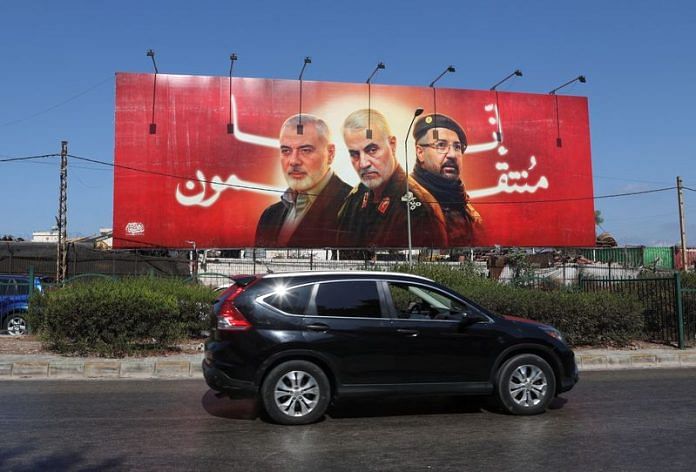DUBAI (Reuters) – If Iran retaliates for the assassination of its close ally Hamas leader Ismail Haniyeh in Tehran last week, its regional allies – known as the “Axis of Resistance” to Israel and U.S. influence in the Middle East – are likely to join in.
Built up over decades of Iranian support, the Axis includes not only Hamas, the Palestinian Islamist group that ignited the Gaza war by attacking Israel on Oct. 7, but also the Hezbollah movement in Lebanon, Yemen’s Houthi militia, and various Shi’ite Muslim armed groups in Iraq and Syria.
LEBANON’S HEZBOLLAH
Hezbollah, meaning “Party of God”, was set up by Iran’s Revolutionary Guards in 1982 with the aim of fighting Israeli forces that had invaded Lebanon earlier that year.
The heavily armed group, also an influential player in Lebanon’s politics, shares Iran’s Shi’ite Islamist ideology and is widely regarded as more powerful than the Lebanese state.
Hezbollah has served as a model for other Iranian-backed militias across the Middle East, some of which it has advised or trained. The United States and other governments including U.S.-allied Gulf Arab countries list Hezbollah as a terrorist organisation.
Hezbollah has been mounting near-daily attacks on Israeli targets at the Lebanese-Israeli border since early October, prompting the heaviest exchanges of fire between the enemies since a full-scale war in 2006.
Hezbollah says its attacks have helped to stretch the Israeli army while also uprooting tens of thousands of Israelis who have fled homes near the border. Israeli air and artillery strikes have forced tens of thousands of Lebanese to flee.
Israel has killed some 350 Hezbollah combatants including some top commanders in Lebanon since Oct. 7, according to a tally of death notices issued by the group.
Israel killed Hezbollah’s highest commander Fuad Shukr in an airstrike on Beirut on July 30, saying this avenged a rocket attack that killed 12 youngsters a few days earlier in a Druze village in the Israeli-occupied Golan Heights.
Hezbollah denied involvement in the rocket attack.
YEMEN’S HOUTHIS
The Houthi movement established control over large parts of Yemen during a civil war that began in 2014, when it seized the capital Sanaa and overthrew a government backed by Saudi Arabia, the Middle East’s leading Sunni Muslim power and Iran’s main rival for regional influence.
The Houthis belong to the Zaydi sect of Shi’ite Islam and have long had friendly ties to Iran.
The Yemen war pitched them into conflict with Saudi Arabia and its Gulf allies who, wary of Iran’s broadening sway, intervened in the war in 2015 in support of the ousted government. Saudi Arabia has in recent years backed diplomatic efforts to end the war, last September hosting Houthi negotiators in Riyadh.
The Houthis announced on Oct. 31 they had entered the Gaza conflict by firing drones and missiles towards Israel.
In November, they expanded their role by attacking shipping in the southern Red Sea, saying they were aiming at vessels belonging to Israelis or heading to Israeli ports – though some of the targeted ships had no known link to Israel.
The campaign prompted the U.S. and Britain in January to carry out airstrikes on Houthi targets in Yemen. The Houthis declared all U.S. and British ships and warships taking part in “the aggression” would be targets for their strikes.
The attacks have disrupted international commerce on the shortest shipping route between Europe and Asia, leading some shipping companies to reroute their vessels.
Sources told Reuters in January that commanders from Iran’s Revolutionary Guards and Hezbollah were on the ground in Yemen helping direct and oversee Houthi attacks on shipping. The Houthis denied any Hezbollah or Iranian involvement, as has Iran itself.
ISLAMIC RESISTANCE IN IRAQ
Shi’ite groups with links to Iran emerged as powerful players in Iraq after the 2003 U.S.-led invasion, and developed militias with tens of thousands of fighters.
An umbrella group of Shi’ite Islamist armed factions called Islamic Resistance in Iraq began targeting U.S. forces stationed in Iraq and Syria last October, saying they aimed to respond to Israel’s offensive against Hamas in Gaza and to resist U.S. forces deployed in Iraq and the region.
The attacks stopped after a drone strike killed three U.S. soldiers in Jordan on Jan. 28, prompting heavy retaliatory U.S. airstrikes on Iran-linked targets in Syria and Iraq.
Reuters reported in February that the head of Iran’s Quds Force asked the militias to lie low to avoid U.S. strikes on their senior commanders, destruction of key infrastructure or even a direct retaliation against Iran.
On April 1, Islamic Resistance in Iraq claimed responsibility for an aerial attack on Eilat in Israel.
Shi’ite armed groups fighting as part of Hashd al-Shaabi (Popular Mobilisation Forces) had played a leading role in Iraq in battling the ultra-hardline Sunni Islamist Islamic State group, which held swathes of Iraq and Syria from 2013 to 2017.
While members of these Shi’ite armed groups receive state salaries and are technically under the prime minister’s authority, they often operate outside the Iraqi military chain of command. Their arsenal includes explosive drones, rockets and ballistic missiles.
SYRIA
The Syrian government led by President Bashar al-Assad is part of the Axis of Resistance but has not played any direct role in the current conflict.
However, Syrian territory has been an arena of escalation.
This has included attacks by Iran-backed militias on U.S. forces in the east and Israeli airstrikes in Syria against Iranian personnel and interests, among them an April 1 strike on the Iranian embassy compound in Damascus.
Israeli strikes have also killed Hezbollah members in Syria, and there have been occasional exchanges of fire between the Israeli-occupied Golan Heights and southwest Syria.
(Writing by Timour Azhari and Tom Perry; Editing by Michael Georgy and Mark Heinrich)
Disclaimer: This report is auto generated from the Reuters news service. ThePrint holds no responsibilty for its content.



